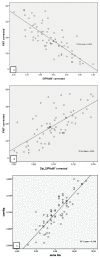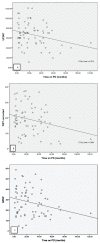Two-in-one protocol: simultaneous small-pore and ultrasmall-pore peritoneal transport quantification
- PMID: 22383631
- PMCID: PMC3524870
- DOI: 10.3747/pdi.2011.00175
Two-in-one protocol: simultaneous small-pore and ultrasmall-pore peritoneal transport quantification
Abstract
Background: Reduced free water transport (FWT) through ultrasmall pores contributes to net ultrafiltration failure (UFF) and should be seen as a sign of more severe functional deterioration of the peritoneal membrane. The modified peritoneal equilibration test (PET), measuring the dip in dialysate Na concentration, estimates only FWT. Our aim was to simultaneously quantify small-solute transport, FWT, and small-pore ultrafiltration (SPUF) during a single PET procedure.
Methods: We performed a 4-hour, 3.86% glucose PET, with additional measurement of ultrafiltration (UF) at 60 minutes, in 70 peritoneal dialysis patients (mean age: 50 ± 16 years; 61% women; PD vintage: 26 ± 23 months). We calculated the dialysate-to-plasma ratios (D/P) of creatinine and Na at 0 and 60 minutes, and the Na dip (Dip(D/PNa60')), the delta dialysate Na 0-60 (ΔDNa(0-60)), FWT, and SPUF.
Results: Sodium sieving (as measured by ΔDNa(0-60)) correlated strongly with the corrected Dip(D/PNa60') (r = 0.85, p < 0.0001) and the corrected FWT (r = 0.41, p = 0.005). Total UF showed better correlation with FWT than with indirect measurements of Na sieving (r = 0.46, p < 0.0001 for FWT; r = 0.360, p < 0.0001 for Dip(D/PNa60')). Corrected FWT fraction was 0.45 ± 0.16. A negative correlation was found between time on PD and both total UF and FWT (r = -0.253, p = 0.035 and r = -0.272, p = 0.023 respectively). The 11 patients (15.7%) diagnosed with UFF had lower FWT (89 mL vs 164 mL, p < 0.05) and higher D/P creatinine (0.75 vs 0.70, p < 0.05) than did the group with normal UF. The SPUF correlated positively with FWT in the normal UF group, but negatively in UFF patients (r = -0.709, p = 0.015). Among UFF patients on PD for a longer period, 44.4% had a FWT percentage below 45%.
Conclusions: Measurement of FWT and SPUF is feasible by simultaneous quantification during a modified 3.86% glucose PET, and FWT is a decisive parameter for detecting causes of UFF in addition to increased effective capillary surface.
Figures



References
-
- Heimbürger O, Waniewski J, Werynski A, Tranæus A, Lindholm B. Peritoneal transport in CAPD patients with permanent loss of ultrafiltration capacity. Kidney Int 1990; 38:495–506 - PubMed
-
- Krediet RT, Imholz AL, Struijk DG, Koomen GC, Arisz L. Ultrafiltration failure in continuous ambulatory peritoneal dialysis. Perit Dial Int 1993; 13(Suppl 2):S59–66 - PubMed
-
- Selgas R, Bajo MA, Castro MJ, del Peso G, Aguilera A, Fernández-Perpén A, et al. Risk factors responsible for ultrafiltration failure in early stages of peritoneal dialysis. Perit Dial Int 2000; 20:631–6 - PubMed
-
- Monquil MC, Imholz AL, Struijk DG, Krediet RT. Does impaired transcellular water transport contribute to net ultrafiltration failure during CAPD? Perit Dial Int 1995; 15:42–8 - PubMed
-
- Ho-dac-Pannekeet MM, Atasever B, Struijk DG, Krediet RT. Analysis of ultrafiltration failure in peritoneal dialysis patients by means of standard peritoneal permeability analysis. Perit Dial Int 1997; 17:144–50 - PubMed
Publication types
MeSH terms
Substances
LinkOut - more resources
Full Text Sources

